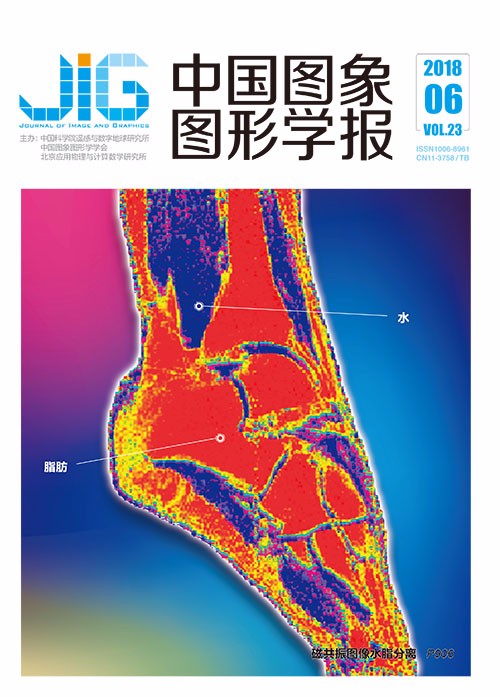
相位分区和局部多项式曲面拟合的相位解缠绕
摘 要
目的 准确的解缠绕相位是两点或三点Dixon技术等在磁共振临床应用的前提和关键,然而当相位图像中存在严重噪声、快速相位变换或不连通区域时,当前许多已经提出的相位解缠绕算法将会失败。为此本文提出一种基于相位分区和局部多项式曲面拟合的相位解缠绕新方法,该新方法在相位图像存在严重噪声、快速相位变换或不连通区域的情况下仍可以稳定可靠的工作。方法 首先将获得的相位图像分成连通块,块内相位都在给定的相位区间内,把像素个数小于给定阈值的块归类为残余像素。然后利用局域增长的局部多项式曲面拟合方法依次进行块与块之间相位解缠绕和残余像素相位解缠绕。最后使用仿真与真实磁共振Dixon数据来评价提出方法,并与PRELUDE (phase region expanding labeler for unwrapping discrete estimates)方法进行了比较。结果 在不同信噪比、快速相位变换或存在不连通区域的仿真实验中,即使当数据中存在信噪比为0.5、相邻相位变换大于π弧度或不连通区域时,提出方法的平均错误率不大于0.51%。对于100层真实的磁共振膝关节和踝关节水与脂肪分离图像,提出方法生成结果中发生明显解缠绕错误及水与脂肪互换的比率为6.00%,而PRELUDE却为42.00%。结论 本文提出了一种磁共振相位解缠绕算法,利用相位分区方法,可靠的实现相位图像分块;利用局部多项式曲面拟合方法,准确的实现相位解缠绕。提出方法能够更加鲁棒的实现相位解缠绕,这将有益于相位相关的磁共振临床的应用,如两点和三点Dixon水脂分离技术、磁敏感加权成像和人脑相位成像等。
关键词
New phase-unwrapping method based on phase partition and local polynomial surface fitting
Cheng Junying1,2, Wang Changqing1,2, Feng Yanqiu1, Chen Wufan1,2(1.School of Automation Engineering, University of Electronic Science and Technology of China, Chengdu 611731, China;2.School of Biomedical Engineering, Southern Medical University, Guangzhou 510515, China) Abstract
Objective An accurate phase map is crucial for magnetic resonance imaging (MRI)-based clinical applications, such as two-point and three-point Dixon techniques, susceptibility-weighted imaging, and human-brain phase imaging. However, the phase calculated from the complex MR signal is commonly wrapped back into the range of (-π, π] for the arctangent operation. Phase unwrapping is required to recover the underlying actual phase. A certain number of phase unwrapping methods have been proposed under the assumption that the underlying actual phase difference between adjacent pixels should not be larger than π. If the wrapped phase map contains severe noise, rapid phase change, or even disconnected regions in the interesting region, then the underlying actual phase difference between adjacent pixels may be larger than π; thus, this assumption becomes invalid. A new phase-unwrapping method is proposed; this method is based on phase partition and local polynomial surface fitting, which works robustly under the situation of severe noise, rapid phase changes, and disconnected regions. Method The proposed method first exploits the phase partition method to split the acquired phase map into the connected blocks. The phase inside each block remains within a given interval, and the wrapped phase difference between adjacent pixels is less than π. Therefore, no phase wrap exists inside each block. To reduce the affection of noise, the blocks with pixel number of less than a given threshold (such as 50) are clustered into residual pixels. Then, the proposed method sequentially performs inter-block phase unwrapping and residual-pixel phase unwrapping by a region-growing local polynomial surface fitting approach. Three simulated datasets were separately generated with signal-to-noise ratios (SNRs) varying from 6.5 to 0.5, phase height changing from 100 rad to 200 rad, and disconnected regions to test the performance of the proposed method on the data under the situation of severe noise, different phase change levels and disconnected regions. The three-point Dixon knee and ankle data of five healthy adult human volunteers were acquired on a 0.35 T permanent magnet MR scanner to test the performance of the proposed method on the in vivo MR data (XGY-OPER, Ningbo Xingaoyi, Ningbo, China). In addition, the two-point Dixon knee data of one healthy volunteer were acquired on a 3.0 T MR scanner (Philips, Achieva, Netherlands). The simulation and in vivo two-point and three-point water-fat Dixon data were used to evaluate the proposed method and compared with phase-region expanding labeler for unwrapping discrete estimates (PRELUDE). The unwrapped error ratio was calculated as the number of inaccurate unwrapped pixels divided by the total number of pixels to quantitatively evaluate the performance of the proposed method. Each simulation was repeated 20 times, and the corresponding means and standard deviations (SDs) of unwrapped error ratio (%) were calculated. The unwrapped results were implemented via Dixon technique to produce water and fat images to evaluate the performance of the proposed method on in vivo data. If the phase-unwrapping method does not acquire an accurate phase map, then the water and fat images will contain swaps. The water-fat separation results of every slice were evaluated by a blinded board-certified radiologist according to the following four-point scale: 1) many swaps (slices), 2) few swaps (slices), 3) total swap slices, and 4) error ratio. Result 1) In the simulation experiment of different signal-to-noise ratio (SNR) levels, the phase map unwrapped by PRELUDE contains evident wrapping residues in low SNR regions. However, the unwrapped error is substantively reduced in the results generated by the proposed method. The proposed method consistently produced a substantially lower mean and SD of unwrapped error ratio than those of PRELUDE when SNR is below 2.5. 2) In the simulation experiment of different phase change levels, the unwrapped results produced by PRELUDE contain evident wraps when the phase height increased to 200 rad. On the contrary, the proposed method consistently produced accurate unwrapped results for different phase heights. 3) In the simulation experiment of existing discontented regions, PRELUDE generated results with serious wrapping residues, and the mean and SD of the unwrapped error ratio was 12.79±0.67 (%). The proposed method produced an accurate unwrapped phase with the mean and SD of unwrapped error ratio of 0.10±0.05 (%). 4) In the in vivo 0.35 T datasets of five volunteers and the 3.0 T dataset of one volunteer (a total of 100 slices, consisting of 75 sagittal knees and 25 sagittal ankles) water-fat separation experiments, the results generated by PRELUDE had nine times many swaps and 33 times few swaps out of 100 outputs. Meanwhile, the proposed method only produced six times few swaps. The total error ratio of PRELUDE was 42% and that of the proposed method was only 6%. Conclusion A new phase-unwrapping method, which first splits the acquired phase map into connected blocks by exploiting the phase partition method, is presented. The blocks with the pixel number of less than a given threshold are clustered into the residual pixels. Then, the proposed method sequentially performs inter-block phase unwrapping and residual-pixel phase unwrapping by using a region-growing local polynomial surface fitting approach. The simulation results demonstrate that the proposed method can achieve robust and accurate phase unwrapping even under serious noise, rapid phase changes, and disconnected regions. The application on two-point and three-point water-fat Dixon MRI data shows that the proposed method can successfully separate water and fat with few swaps. Therefore, the proposed method is beneficial to phase-related MRI applications, such as two-point and three-point Dixon techniques, susceptibility-weighted imaging, and human-brain phase imaging.
Keywords
magnetic resonance imaging phase unwrapping phase partition local polynomial surface fitting water-fat separation
|



 中国图象图形学报 │ 京ICP备05080539号-4 │ 本系统由
中国图象图形学报 │ 京ICP备05080539号-4 │ 本系统由